How we’ve changed after one year of the coronavirus pandemic
We have ditched cash for cards, we buy more items online but fewer clothes, we smoke less and adopt more animals. The data reflects how everyday lives in Spain have been transformed in a way that may be here to stay
Masks as a vital accessory, hand sanitizer at every turn, video calls with grandma who barely knew how to use a cellphone a year ago: the coronavirus pandemic has turned our daily habits upside down.
Some of the changes are highly visible, such as face masks and video calls, but a statistical analysis of different sectors during 2020 flags up other adjustments we may not be so aware of, such as the fact we have largely ditched the use of cash, or that we buy 40% fewer clothes given that we have less occasion to show them off. Those who have jobs have increased their savings but investment in property has fallen as the future remains uncertain. We study and work remotely, we go less to the gym and do more outdoor sport; we smoke and drink less in general, but we do both slightly more at home. Restaurant dining has been replaced by takeout meals and, of course, we travel far less. These new habits are becoming so ingrained that it is likely many of them are here to stay even once the restrictions are finally lifted.
A new routine
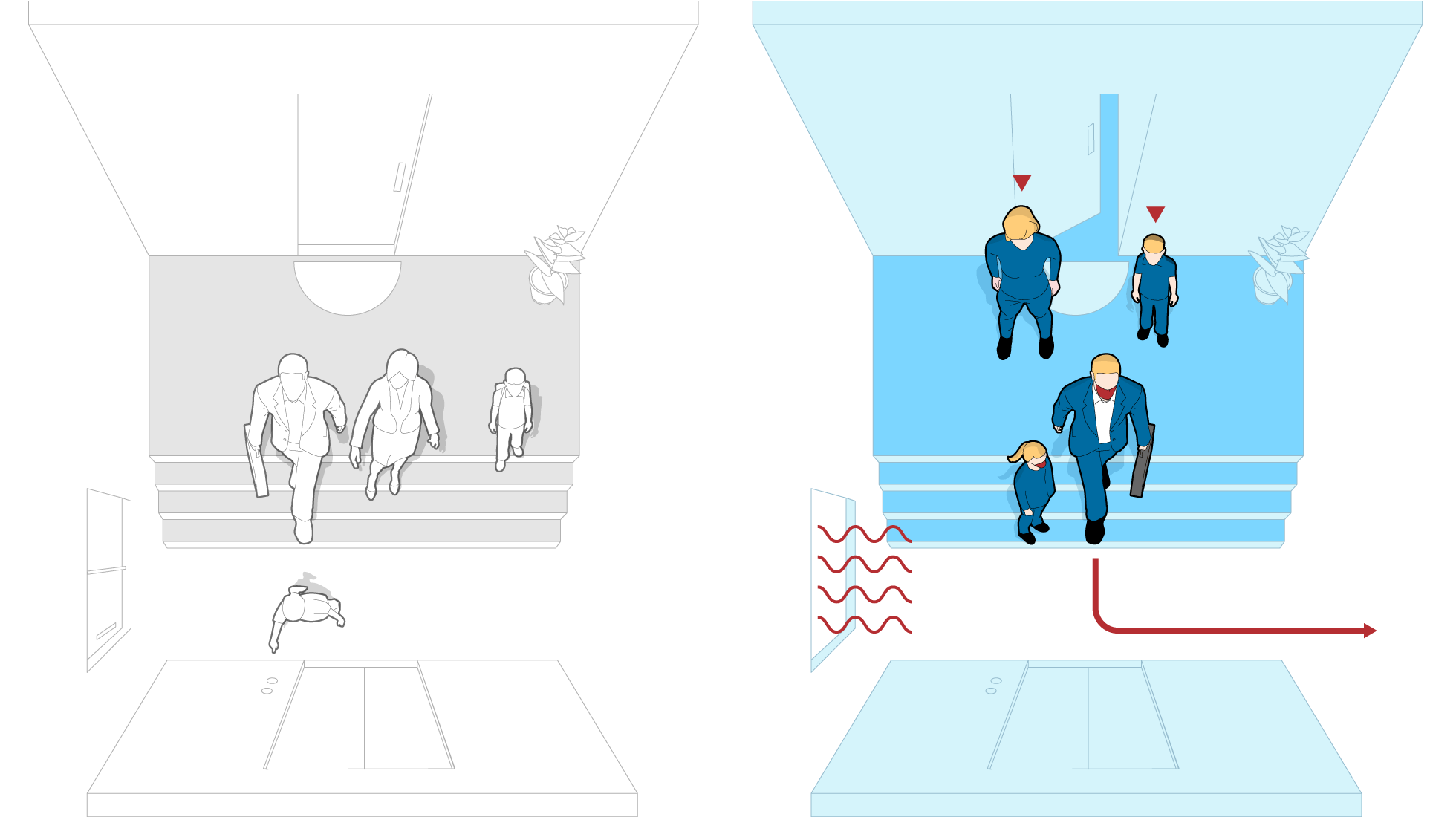
Homeworking
Quarantine
Masks
Stairs
Ventilation
Elevator
LEAVING HOME. The coronavirus pandemic has disrupted our daily routines. The face mask has become a mandatory accessory in public while ventilation in enclosed spaces is now essential to keep the air clean. But leaving the house at all is now less common as the number of employees required to work from home tripled in 2020 while those caring for a quarantined minor have also been confined to the home. After the Christmas vacation, students in 1.2% of the country’s classrooms (4,000 classes) have had to isolate. The peak was in October 2020, when the figure reached 2%.
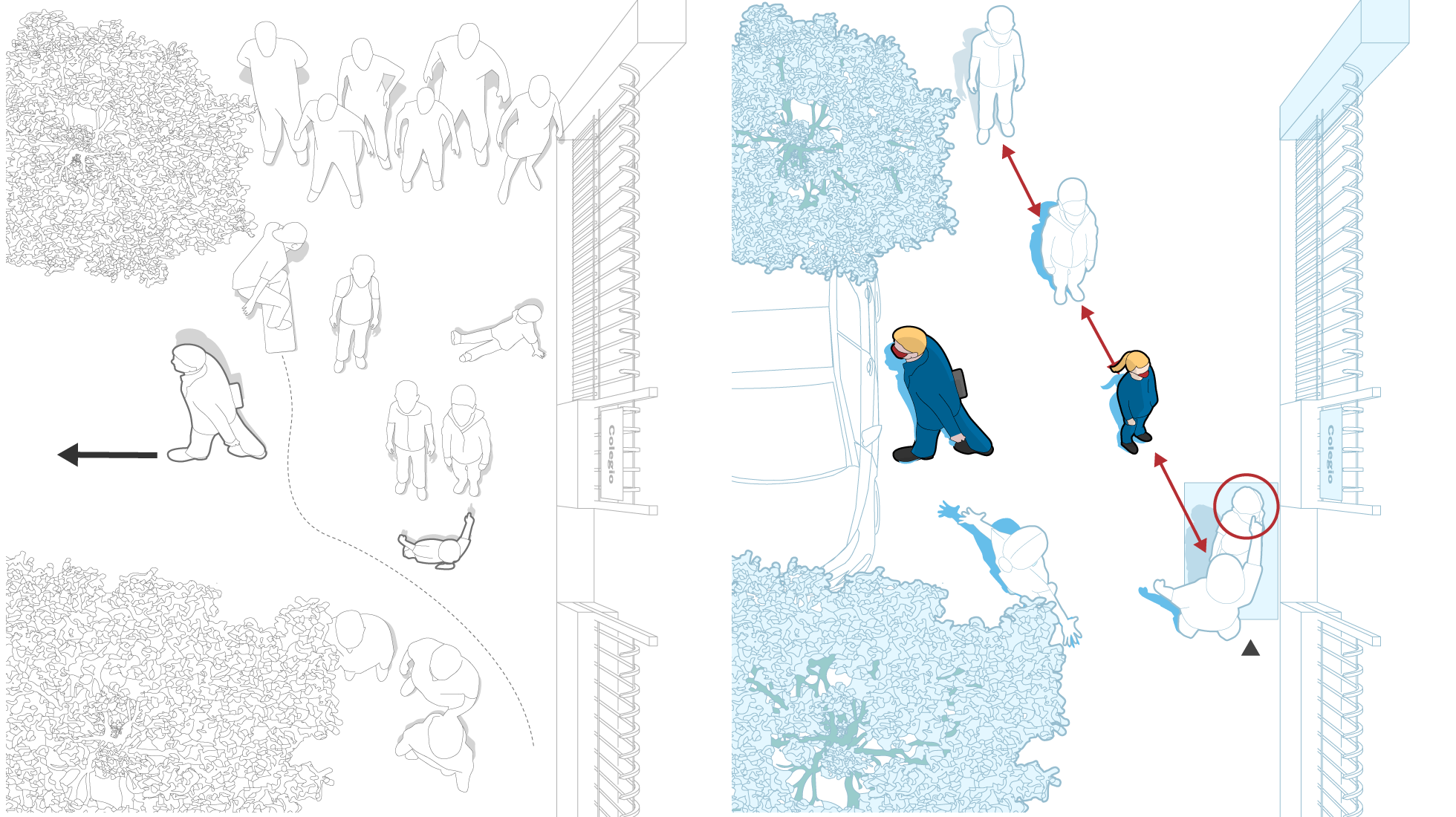
1.5 m
1.5 m
Subway
1.5 m
Car
Disinfecting mat
and temperature taken
SCHOOL ACCESS AND TRANSPORTATION. A year ago, the typical scene at school gates was of children milling around and parents chatting. Now, each family group waits in line, separated from other family groups by 1.5 meters. The children enter one at a time, their shoes are disinfected and a member of staff takes their temperature. Once parents have dropped their children off, they tend to use the car if they have to go to work. Public transportation has seen a 40% to 50% drop in 2020, while commuting by car has fallen by 15% to 20%.
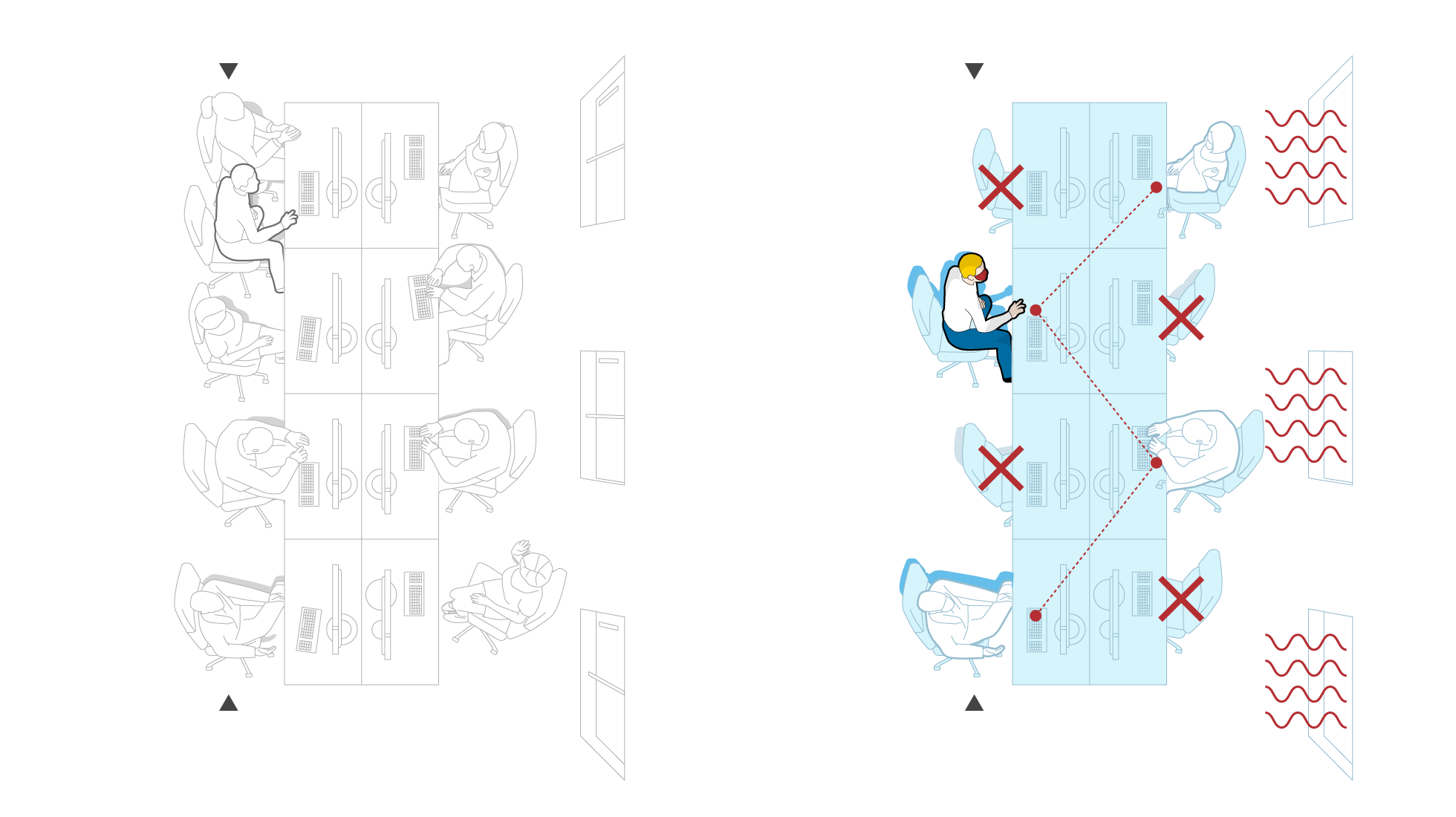
Bigger social life
Empty seats
Ventilation
Seats taken
Zigzag seating
AT WORK. Social distancing has been imposed in the workplace, where it is now common to find alternate seats empty in order to maintain a 1.5-meter distance. Group meals have been replaced by individual meals eaten at desks, meetings have been reduced and videoconferencing has been encouraged while hygiene measures have been meticulously followed, in compliance with the recommendations made by the Health Ministry in its guide, Good practices in the workplace. In accordance with its advice, companies must also implement all the necessary protective measures for staff dealing with the public.
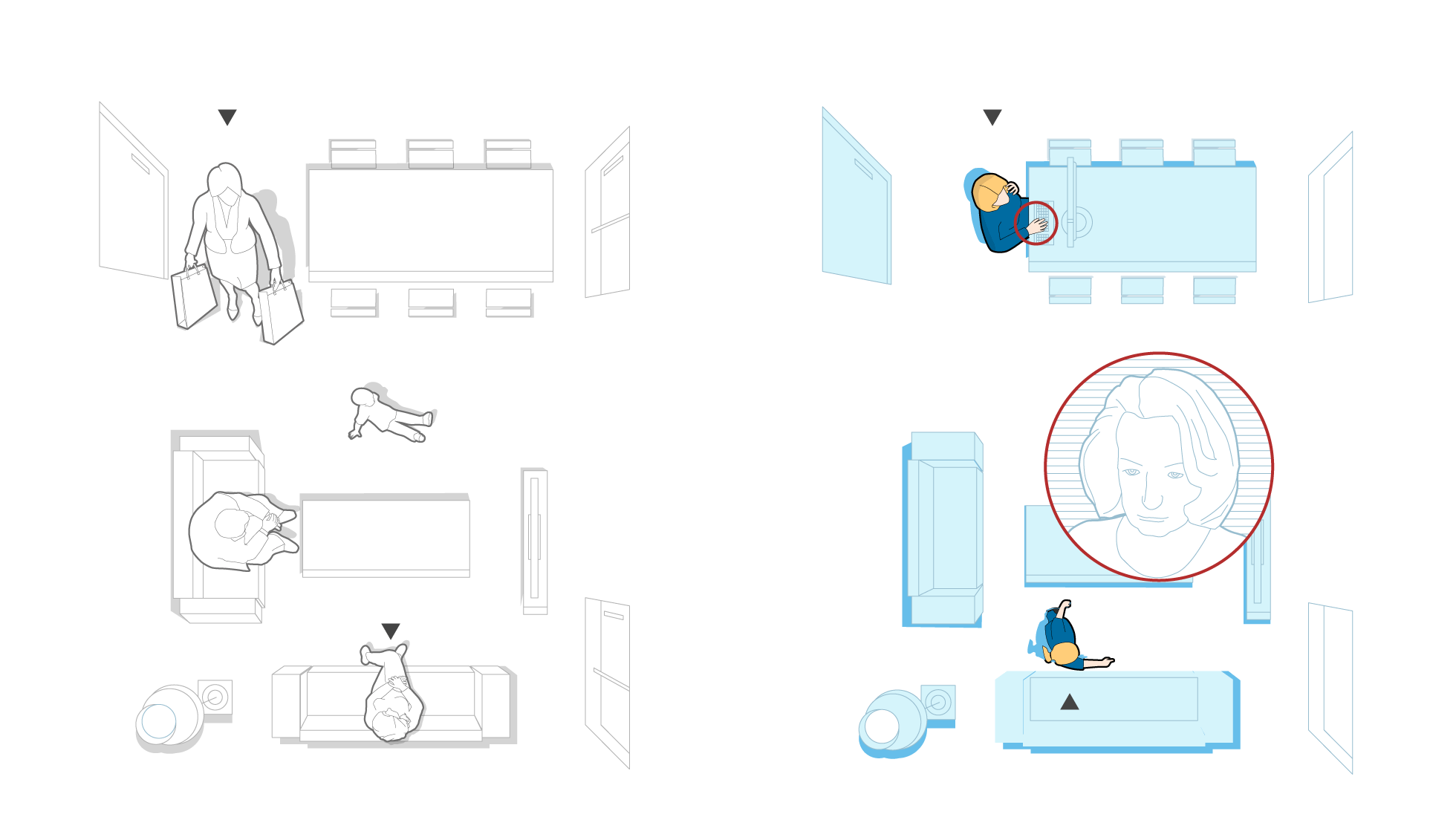
Shopping in person
Shopping online
Grandparents
Videoconferencing
GROCERY SHOPPING AND SOCIAL LIFE. Although supermarkets and other essential stores have remained open since the pandemic broke out, many consumers have turned to e-commerce, which now accounts for 14% of sales, up from 9% a year ago, experiencing as much growth in one year as over the previous five years. Meanwhile, social relationships have suffered something of a hiatus. Many nursing homes have limited or stopped visits due to the pandemic, and seeing relatives and friends in person has been largely replaced by videoconferencing. In the space of a year, Zoom has gone from 10 million users to 300 million globally.
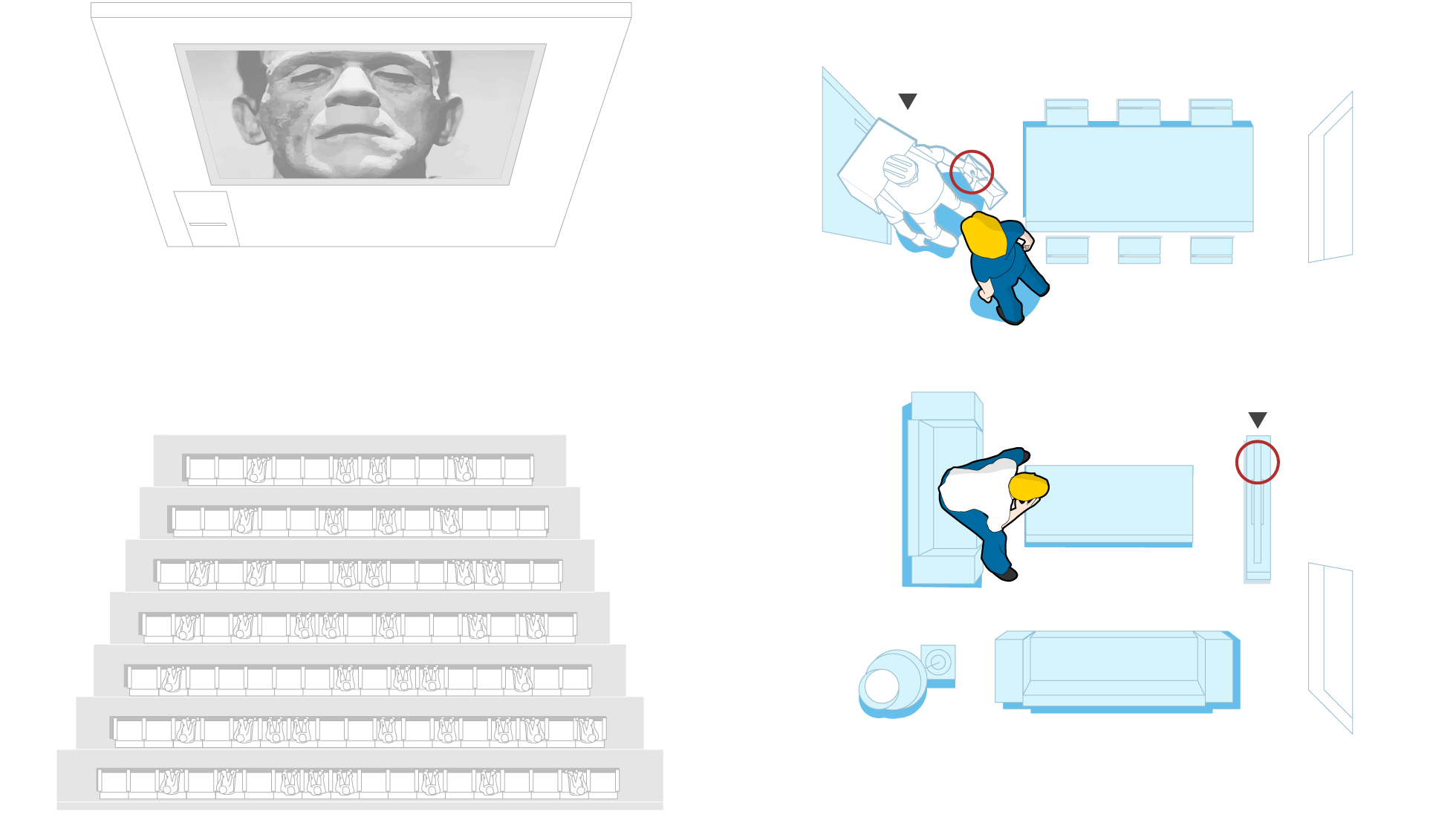
Takeaway meals
Cinemas
and theaters
with no restricted capacity
Films
and TV series
at home
ENTERTAINMENT AND DINING. Movie theater attendance has dropped from 105.5 million in 2019 to 28.2 million in 2020. The theater industry has also experienced major setbacks, with a 62% plunge in audience numbers. Meanwhile, streaming TV platforms have multiplied subscriber figures. According to one survey, 35.3% of people interviewed in 2019 said they had consumed movies or series on Netflix. In 2020, that figure rose to 44.9%. Another big casualty in leisure has been the food and drink sector: the number of bars and restaurants has fallen by 27% in the past year. At the same time, home food delivery has skyrocketed and Glovo, JustEat and UberEats have gone from a combined total of 23,000 restaurants on their books to 44,000.
Triumph of the small screens
Cinemas and theaters have been seriously hit by the pandemic. According to industry leaders, movie theaters lost 72% of their audience in 2020, and theaters 62%. So how do we enjoy ourselves now? Glued to the screen, but at home: if we watched TV for an average of three hours and 41 minutes in 2019, last January we were clocking up four hours and 19 minutes. We are also consuming far more movies and TV series on digital platforms such as Netflix, HBO, Filmin, Amazon Prime and Disney. According to the General Study of Media (EGM), half of Spain’s population is subscribed to one platform or another compared to 33.7% in 2019. Meanwhile, iVoox, one of the main online audio applications, has increased its user figures by 30% in Spain.
As Joaquim Rius, who teaches social anthropology at the University of Valencia, explains: “Lockdown has digitalized social, labor and consumer relations. The digital world has facilitated our ability to keep going, but it has also established new rules with winners and losers. The cultural sector is one of the big losers in Spain because there are now large corporations taking a significant slice of the film, book and music pie,” he adds. “The 2020 data reveals that entire sectors within the cultural industry have disappeared. If they don’t get a strong injection of support from the public sector, cinemas and theaters will find that their audiences will not return once they are able to open normally.”
Despite spending more time at home, we haven’t been doing much more reading. The Reading Barometer shows that during the lockdown, frequent readers who read at least once a week went from 50% to 57% from the previous year, but when the lockdown was lifted, that figure eased to 53%, indicating only a slight rise. On the other hand, we played more as a family: sales of board games grew by 8%, puzzles by 30% and construction toys by 50%, according to Spanish manufacturers.
Fewer bars and restaurants
Of the 316,000 hospitality establishments operating in 2019, 85,000 have closed down. The sector’s sales volume between January and November 2020 was 50% lower than during the same period in 2019, amounting to losses of €70 billion, according to the Spanish Confederation of Food and Drink Businesses. On the other hand, we order more food at home: JustEat, UberEats and Glovo, three of the main delivery services, have doubled the number of restaurants they collaborate with – 16,000 for JustEat, 13,000 for UberEats and 18,000 for Glovo.
But substituting restaurants for takeout food is not necessarily a satisfactory exchange. According to Carlos María Alcover, professor of social psychology at Rey Juan Carlos University in Madrid, “the satisfaction we get from having food delivered to the home is much lower than the satisfaction we get from going to a real restaurant. Even if the menu is the same, it is an anti-climax if not done in the usual environment. It’s not just what you eat in a restaurant, but the ceremony around it.”
We have also cooked more: the AECOC food industry and distribution association reveals that sales in the food sector grew by 6.4% in 2020, both in fresh produce (6.5%) and packaged (6.4%).
As we go less to bars, we also drink and smoke less. The wine, beer and spirits business associations confirm a drop in sales of between 40% and 50% in the hospitality sector, although there is a slight increase in sales to individuals. For example, in 2019, 11.07 million hectoliters of wine were sold, 3.55 million of them for home consumption; in 2020 there were 9.06 million hectoliters sold, but more of that was drunk at home (4.57 million). The Tobacco Board meanwhile confirms that sales of cigarette cartons have fallen by 8%. Alcover considers that “both alcohol and tobacco consumption are very social; there are people who do not drink at home, but do drink outside with friends. People don’t normally buy a good bottle of wine to drink at home alone. Because it’s not about the wine or the whisky, but about the environment.”
Aversion to cash
“There has been a shift from cash to credit cards. A recent study by Minsait shows that 70% of Spaniards have reduced their use of cash or stopped paying with it altogether, and 60% have been averse to touching cash or going to an ATM,” says José Luis Nueno, the Intent HQ Chair on Changing Consumer Behavior at IESE Business School. In the second quarter of 2020, the Bank of Spain states that we withdrew almost 52% less cash from cash machines, and in the third quarter, 26% less; on the other hand, credit card transactions only decreased in the second quarter, while in the third quarter they increased by 16%, the same rate as the previous year.
Uncertainty regarding the future has also meant we are taking out less consumer credit – a drop of around 30% – and buying fewer properties – a decline of 17%. “Household savings in the euro zone have reached unprecedented levels, primarily because the lockdown prevented consumption but also because of uncertainty: people are afraid of losing their jobs or getting a worse one, so they are being cautious and delaying decisions on purchases,” notes Nueno. Between January and September 2020, Spaniards saved almost €40 billion, according to the Bank of Spain.
Buying sweatpants from the sofa
We are going less to stores. The Spanish Confederation of Commerce estimates a drop in retail sales of between 20% and 25% while around 15% of stores have closed. According to Nueno, “there is a fear of going to establishments, but there is also a weariness at the prospect of waiting in line. People are going less to the physical point of sale, and that trend may continue [beyond the pandemic].”
On the other hand, we buy more online, according to the Spanish Digital Economy Association, which states, “In 2020, tourism transactions and ticket sales for concerts and shows – two of the most relevant digital sectors – collapsed for obvious reasons, while others such as food, fashion and consumer electronics grew significantly, possibly by more than 30%.”
Nueno adds that consumers have taken to online shopping and four sectors have benefited greatly from this, namely, food, which has doubled its online share from 2% to 4% translating into 14% growth; fashion, which has increased its share through luxury marketplaces; electronics, which has benefited from remote working; and household products, decoration and DIY. There has also been tremendous growth in food delivery.
“E-commerce has gone from 9% to 14% which means it has grown in one year as much as in the previous five,” Nueno points out. More fashion has been sold online but, in general, we have bought far less clothing: the Business Association of Textile Commerce estimates a drop of 41% over the year. A spokesperson for the department store El Corte Inglés says that “habits have shifted towards more comfortable clothing, for living or working at home, and away from what’s coming out in any given season.”
Both El Cortes Inglés and the sports retailer Decathlon confirm that they have sold far more clothing and articles related to doing sport at home. After the lockdown, we have tended more towards individual outdoor sports, such as running and cycling. Bicycle sales grew by 30% last May and, although the sector does not yet have figures for the year, significant growth in sales is expected. On the other hand, we have stopped going to the gym: FNEID, an association for sports centers, estimates a 53% drop in turnover and a 50% slide in the number of members.
More Zoom and less high-speed rail
As mobility restrictions continue, it is not surprising that we now travel far less: 66% less on the high speed AVE trains and 60% less on Renfe’s medium-distance trains, trumped by a 72% drop in air travel as weekend getaways remain a distant dream. In cities, the use of public transportation has fallen by between 40% and 50%, while car use has only fallen by between 15% and 20%, according to November data compiled by EL PAÍS. The mobility data can be accounted for by the fear of transmission in crowded areas, although public transportation is, in general, safe.
We are increasingly working and studying at home. In 2019, 4.8% of employees worked from home regularly – more than half of their working days – and another 3.5% occasionally, according to the National Statistics Institute (INE). In 2020, those figures tripled: in the first quarter, regular remote workers amounted to 16.2% of the workforce; in the second and third quarters, that figure eased back to 10%.
Something similar is occurring at universities: enrollment in the large on-site universities has fallen slightly this year while rising sharply in two of the main distance learning universities, such as the National University of Distance Education (UNED) (13%) and the Open University of Catalonia (OUC) (14%), where enrollment is still open. In secondary education, only four regions of Spain have full in-person attendance, while another 13 use a hybrid learning approach with alternate days of in-person and online classes. Meanwhile, videoconference apps have grown exponentially around the world: Zoom went from 10 million users to 300 million, while Teams went from 20 million to 115 million.
The desire for a pet or partner
The loneliness of lockdown has led to more people seeking a pet in 2020. The Valencian Computer Registry of Animal Identification (RIVIA) has registered 37.6% more dog adoptions and 17.2% more purchases. While national data is not yet available, a similar trend is expected to be seen across the country. As José Vicente Pestana, a professor of social psychology at the University of Barcelona, points out, “having a pet has a very positive psychological effect, because it is a vehicle for things that families are not able to say to each other’s faces. But we have to watch that this doesn’t end in an explosion of animal abandonment down the line.”
The search for a significant other has also increased, perhaps due to the fact that many people had to go through the lockdown alone. The dating app Adoptauntio says connections were up 20% from 2019; Tinder, a similar service, offers no data but confirms that it was a meeting place for a large number of users. Meanwhile, the marriage agency Lazos has noticed a 20% increase in users.
Greater fear of death
With so many changes within a short period comes an inevitable psychological impact, according to Alcover. “The changes during lockdown were accepted because it was an exceptional situation,” he says. “The subsequent adjustment to new habits has been less well tolerated because when we return to the former situation but cannot do what we did before, we find it more difficult to adapt.”
Alcover believes that sometimes an imposed experience like the one we are currently subjected to can make people change their habits for good. “During the Spanish flu epidemic of 1918, which lasted a long time, contacts were modified and crowds decreased; and after the Great Depression, consumer habits changed,” he says.
A recent Center for Sociological Research (CIS) survey shows that almost one in four Spaniards (23.4%) have felt very or fairly afraid of dying due to the coronavirus, and seven out of 10 (68.6%) have felt very or fairly afraid of losing a family member or loved one. Use of tranquilizers and antidepressants have grown by 4%, according to the Business Federation of Pharmacists. The General Council of Psychology does not yet have figures showing an increase in visits to psychologists, but everything points to the fact that the impact on mental health is going to be significant.
Although we have made more or less the same number of doctor’s appointments as prior to the pandemic, many of these appointments have been over the phone, accounting for 38% of the total in Andalusia and 60% in Galicia – among the few regions releasing this kind of data. The UGT labor union estimates that 75% of the first primary care consultations in Madrid are carried out by phone. Meanwhile, our sight has worsened by 57% due to intensified screen use, according to a study by the organization Visión y Vida.
Finally, there are several social shifts emerging. For example, in the first half of 2020, there were 60.83% fewer weddings, according to the INE, though we do not know if the trend has continued. Divorces grew by 16% in the third quarter, according to the General Council of the Judiciary, but at the end of the year, they fell by 13.3%.
“The fact there are fewer weddings may be because our expectations of the future are uncertain and people cancel their plans,” says Alcover. “And enforced coexistence increases the number of divorces. In fact, the highest number of separations generally occurs after the holidays.”
As for births, they fell by 4% in the first half of the year, according to the INE, but the pandemic has accelerated this trend: partial data from civil registries shows a drop of more than 22% in December and January. This is also the case in neighboring countries: according to a compilation by The Wall Street Journal, births in January were down 21% in Italy and 13.5% in France. The decline in Spain is likely to have an alarming impact on the country’s already low birth rate.
With additional reporting by Yolanda Clemente, Luis Sevillano Pires and Nacho Gallello.
English version by Heather Galloway.

